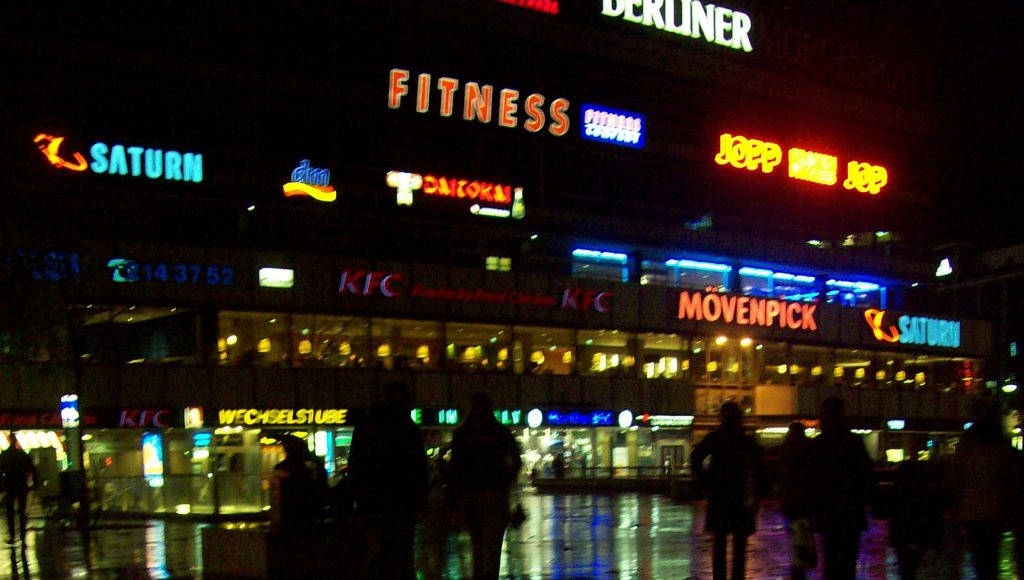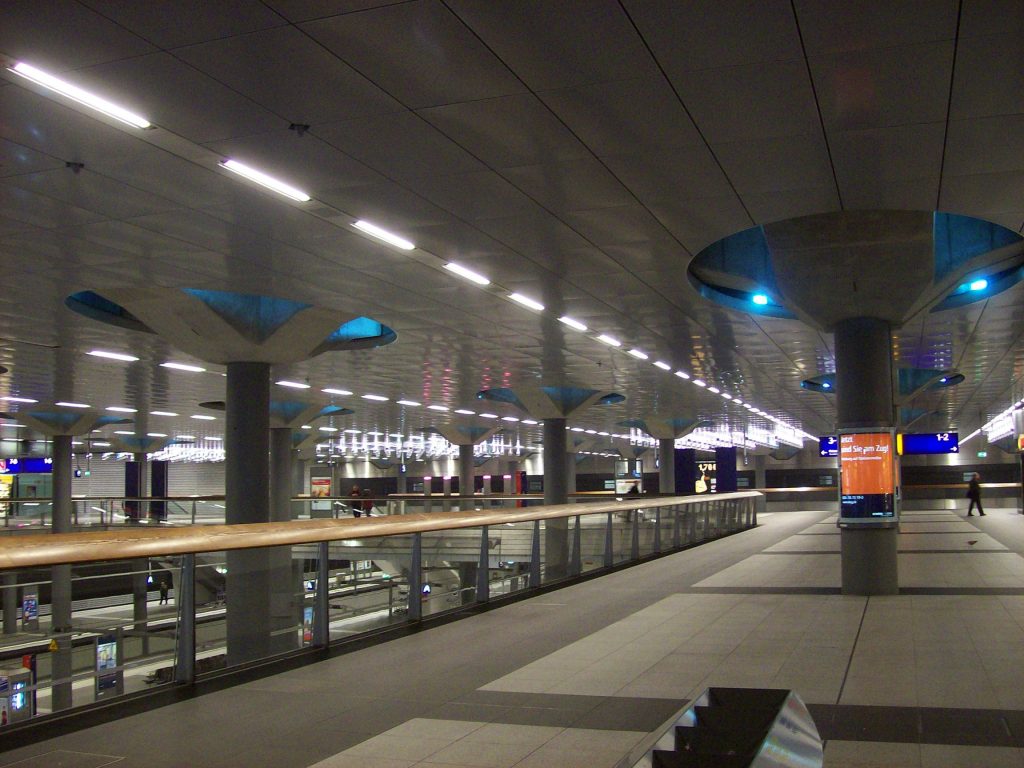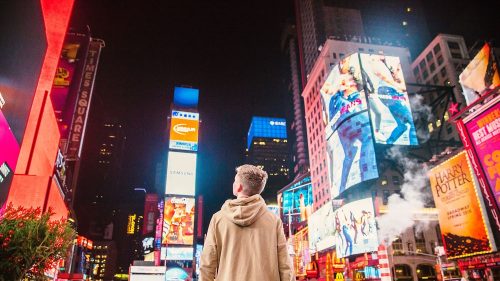In 1928, Ukrainian avant-garde film-maker, Eugène Deslaw (1898-1966), produced a short experimental film recording nightscapes of major cities such as Paris, London, Prague and Berlin. Les nuits électriques, a 12’39,” 35mm, black and white silent film followed the genre of city symphonies popular in the 1920’s, documenting life in major cities. City symphonies were film-poems, recorded usually in daytime, that sought to manifest the rhythm of the city. Deslaw instead went out with his camera at night, recording the spatiality that had emerged in the nocturnal urban array, editing streetlights, illuminated signs, amusement parks, shop lighting, and cafes. Delsaw captured the effect of electric light, and the image of the city at night. In his own words: I believe that the modern night populated with strange and singing light does not resemble any other night at any point in time.1
The origin of our relationship with light can be traced along the development of modern humanity and our evolutionary predecessors. Solar radiation, ultimate source of light, has aeon accompaniedhumanity, generating a neurological and biological association to the properties of the sun. At the same time, due to the twenty-four hour day-night cycle, the absence of the sun suggests a counter association to the properties of night. Hence in the natural world perception of time and space is defined by the circumstances created by the presence or absence natural luminous sources: the sun, the moon and the stars. Ultimately, it would be the brightness and darkness of this cycle, that would forge our association with the environment and define our perception. Therefore time-space in the natural world is characterized by periodicity, the transition of light to darkness, or the passage from the diurnal to the nocturnal state of the world. Characteristics of natural light such as the spectral distribution, color temperature, direction, intensity, have all equally, both literally and figuratively defined our evolutionary process as human beings.
People have always been fascinated with the ability to control their environment. To protect ourselves from the natural elements we built adobes, fabricated clothes, crafted tools and cultivated the earth. Above all, the harvest of fire was the revolutionary force that separated humans from animality. The regular use and control of fire led to the development of new uncharted territory. The light of fire allowed a degree of autonomy from the cycles of day and night and provided protection from the dangers lurking in the dark. In essence, fire provoked new ways of thinking, experiencing and seeing the world around us. Fire became central to human evolution and the development of human culture: people now socialized around the hearth, explored dark spaces of caves and caverns, and decorated their walls creating prehistoric art. The use of flame as a light source, would surprisingly last up to the end of the 19th century when electric light ultimately took over.2
Already by the end of the 19th century big cities had started to change their lighting schemes from gas light to electric light technology, signaling a major shift in the nocturnal urban spatiality. Comparing the two methods of illumination, we find major similarities in the overall logic, principles and motivation. Nevertheless between the two also lies a characteristic break: electric light eliminated the use of the archaic flame as a means of illumination. Experiencing night under the light of candles or the flame of gas burners had created a certain environment associated with a set collection of images. Electric light, accelerating the capacity of activity after dark, produced a new environment that generated new imagery formulated by the interaction of electric light technology with urban space. The new reality would develop its own rhythm and pace which broke away from the archetypal cycles of day and night, creating new space, new environments and new needs. Reconfiguring how we perceive and experience the world around us, and how we individually and collectively think and communicate with each other. In effect, projecting its own values, electric light shaped human experience to fit a reality it had itself created.

Influencing architecture and the built environment, electric light eventually moved people into fully controlled environments removed from nature. Humans found themselves spending most of their time whether day or night indoors while activity after dark became a norm of everyday life. Accustomed to the new reality, urban populations lost touch with the most dominant natural rhythms of nature. The properties of electric light reorganized the interior and exterior appearance of buildings, reshaping the urban environment and changing the way people experienced their daily lives. The capacity of electric light in comparison with previous illumination technologies, in terms of lighting levels, light distribution and visual efficiency, created a new outlook changing the notion of public and private space. The ability of electric light to illuminate and create space independent of nature’s variations revolutionized interior design. Previous lighting technologies depended on combustion while electric light created “clean light.” A typical example of the effect of electric light technology could be seen in the workplace. Electric light reshaped the workplace environment, detaching it from the necessity of daylight. Hence instituting work in daylight deprived environments electric light prolonged traditional working hours changing the pre-existent social and economic status quo.
The capacity of electric light to illuminate exterior space reshaped the appearance of the urban environment. Remodeling the concept of nightlife, electric light offered innumerable activities for socialization after dark,3 dramatically amplifying the existing experience of nightlife introduced by gaslight. Considered as a building material, architects started to take into account the presentation of their buildings at night, materializing what came to be known as architecture of the night. The phenomenon of luminous advertising4 sprung up in all major cities5 adding to the complexity of the urban nightscape. Amusement parks6, illustrated yet another example of night culture, and the dynamic of nocturnal entertainment introducing state of the art electric illumination. The organization of mobility which for thousand of years had been governed by the movement of the sun, was also prey to change: vehicles, street lighting and traffic light would transform the meaning of transportation, and the way people moved around the city at night.


The transcendent effects of electric light were first showcased in the testing grounds of the International Expositions and World Fairs of the 19th century. When electric light technology was transferred to the streets, it transformed the image of the city in a “riot of colors, more like a dream city than a real one.”7 From the functionality of street lighting, the illumination of civic monuments, and electric lighting in hotels, cafes, restaurants and shops, to the colorful illuminated advertisements and theatrical marquises. Electric light shaped the visual boundaries of the night conditioning what was to be experienced and seen. In the Exposition Universelle of Paris, in 1889, memorializing 100 years to the French revolution, and Chicago’s World Columbian Exposition, in 1893, celebrating 400 years from the arrival of Columbus, a new visual culture was declared. Both fairs displayed dramatized illumination schemes, expanding the human imagination beyond the limits of its time.8 Brilliant outdoor electric lighting installations: hordes of bulbs, flood lighting, batteries of search lights and color changing illumination in buildings and fountains demonstrated the power of electric light and the bright future ahead.
The novel condition that the human visual system was forced to negotiate with, as a result of the development of gas light would only be the preface of a violent proliferation of imagery designated to forge and organize the visual territory of the post-nocturnal milieu. “If we think of light it has no image, yet it creates images.”9 The core impression of the world comes from our visual system. We receive light through the eye, which thereafter follows a twofold division, the first involves the production of imagery or the visual reality we are all accustomed to, while the second involves biological aspects of the human organism, the circadian rhythm. Our interpretation of reality is the of collection of sensory stimulus processed by the brain. In the nocturnal state of the city, it is electric light in all its expressions that takes control over visual stimuli and dictates the images which construct our perception. Prior to electric light, other forms of light had mediated the nocturnal spatial array, but the circumstances were dramatically different. Electric light accelerated the production of visual stimuli, influencing the way we perceived and experience the world around us while obliging the human visual system to adapt.
Electric light intensified visual stimulation, creating new ways of apprehending the urban environment. Patterns of light, color, and reflection emerged, attuning our visual experience to a new ambience. Today it is most evident in technologically advanced societies through electric light embedded in architecture, public and private space, gadgetry (television, computers, smart phones), the marketplace, (media facades, luminous advertising) and means of public and private transportation. Allied with the capacity that light has to reveal, frame and figure what is, has led to the collective construction of another order. An order which is structuring our sense of time-space and mapping of the postnocturnal city. It is this hyper-mediated visual rhetoric which is radically shaping our way of understanding, modeling our perception of reality.

Electric light as a medium does not simply transmit information, but is actively constructing the perceived reality. The bias of electric light amplifies or reduces visual phenomena allowing certain realities to be more accessible than others, organizing human behavior through the environment it creates. Compare the bright lights of the city center, to a dark alleyway. The illumination of a national monument to an abandoned building. Electric light operates as a luminous text mapping, selecting and formulating the image of the city. As layer of interpretation, electric light in the postnocturnal cityscape can be studied through semiotics. Semiotics is the study of symbols and signs and how meaning is created and communicated. In lieu of mere appearances, analyzing the diffusion and reception of electric light within the context of the postnocturnal city, will reveal the emergent visual language and expose the underlying structures that create and impose meaning.
Electric light generates the nocturnal environment, reinterpreting the diurnal image of the city whilst simultaneously creating new territory. As a medium of representation, electric light as other forms of light before electricity, was utilized as a symbol of power. David Nye author of Electrifying America (1992) has indicated that :”spectacular lighting had moved far beyond functional necessity, and like the displays at world fairs, it served as an instrument of cultural expression providing symbolic validation of the urban industrial order.”10 Today corporate power promoting the 24-hour society is using the medium of electric light to organize an endless cycle of production-consumption.
The effect of electric light can be interpreted in different ways in relation to the culture or context it is examined. Electric light evokes feelings. Different aesthetical and emotional meanings are attached to color, intensity and direction, based on background and culture. Semiotics suggests that language is based on convention and that there is no direct connection between words and the concepts they represent. Based on this premise, postmodern philosophy extended its critique to other forms of communication regarding them also as systems of signs. Language, ideology and culture, self contained and self referential, do not represent a reality outside their self but are instead molding the individual in their own image.
The postnocturnal cityscape examined in the postmodern tradition can be considered as a form of communication which shapes the individual’s perception. The postnocturnal state of the city has created a self-referential reality, a view of the outside world wholly constructed by the medium itself. We are consumers of images, icons, signs of the simulated reality that takes hold of the city at night—there is no more night, there is only that which is mediated.
References
1 Le film “à acteurs” ne me tente absolument pas. J’estime que la nuit moderne, peuplée de lumières étranges et chantantes, la nuit moderne qui ne ressemble vraiment à aucune autre nuit de l’histoire, est photogénique autant, plus encore que le visage d’une belle femme. Je ne travaillais pas selon un scénario préconçu. Je sortais le soir avec beaucoup de foi et mon petit appareil que tout le monde prenait pour un simple appareil photographique. Je me perdais dans la mer, dans la nuit, dans la foule. Je chassais les images comme on chasse des oiseaux. Des vagues sonores déferlaient. Le miracle venait à pas rapides, haletant. Je le saisissais confusément et l’enfermais dans ma boîte. Eugène Deslaw, Filmliga, 1928 / Translation: “I think that the modern night, populated with strange, singing lights, the modern night does not resemble any other night in history, it is as photogenic as, even more than the face of a beautiful woman. I did not work according to a preconceived scenario. I went out at night with a lot of faith and my little camera. I lost myself in a sea, in the night, in the crowd. I hunted images as hunters hunt birds. Sound waves broke. The miracle came rapidly. I confusedly seized it and locked it in my box.”
2 Considering that homo sapiens evolved around 200,000 years ago, and evidence of the widespread control of fire is about 125,000 years ago, it has only been the short period of the last 150 years, that humans have coped with the phenomenon of electric light.
3 Considering the economy and the purpose of this paper, while we do recognize that gas lighting set the foundations for public urban life nightife, we will not investigate the effects of this transition but rather concentrate on the comparison of electric light with the pre-industrialized period of light, focusing on populations subjected to urban nocturnal conditions.In the 1800 ‘s gas lighting prompted a giant leap in the use of artificial light, which furthermore led to the explosion of nightlife culture.
4 O.J. Gude, pioneer in the early 20th century sign advertising business, celebrated outdoor advertisements observing that advertisements “literally forced their announcements on the vision of the uninterested as well as the interested passerby.”
5 Hugo Haring a radical functionalist architect and a figure of functionalism in the 1920’s and 30’s predicted that the ‘nocturnal face’ of a building would be more important than the ‘diurnal face’ and called for the destruction of architecture threw illuminated advertisements.
6 The introduction of state of the art electric lighting first took place in the commercially operated amusement parks. New York, Luna Park (1903) and Dreamland (1904) in Cony Island pioneered the fashion that was soon to spread around the globe, forging the association of the ‘hoi polloi’ with the transcendent effects of electric light; the spectacle reflected the microcosm of a new emerging culture and offered the masses a trance of ‘fairy tracery’ and ‘gilded nights’ seducing the public mind while the crowds rubbed their eyes and pinched themselves to see if what they were experiencing was true.
7 Raymond Hood : ”Architecture of the night: the illuminated building” Dietrich Neumann, Kermit Swiler Champa p.55
8 Look from a distance at night, upon the broad spaces it fills, and the majestic sweep of the searching lights, and it is as if the earth and sky were transformed by the immeasurable wands of colossal magicians ; and the superb dome of the structure, that is the central jewel of the display, is glowing as if bound with wreaths of stars. It is electricity ! When the whole casket is illuminated, the cornices of the palaces of the White City are defined with celestial fire. The waters that are at play leap and flash with it. There are borders of lamps around the Lagoon.[…] A World’s Fair, 1893 by World’s Columbian Exposition (1893 : Chicago, Ill.); Walker, John Brisben, 1847-1931
9 The Vision Machine. Paul Virilio (1994)

